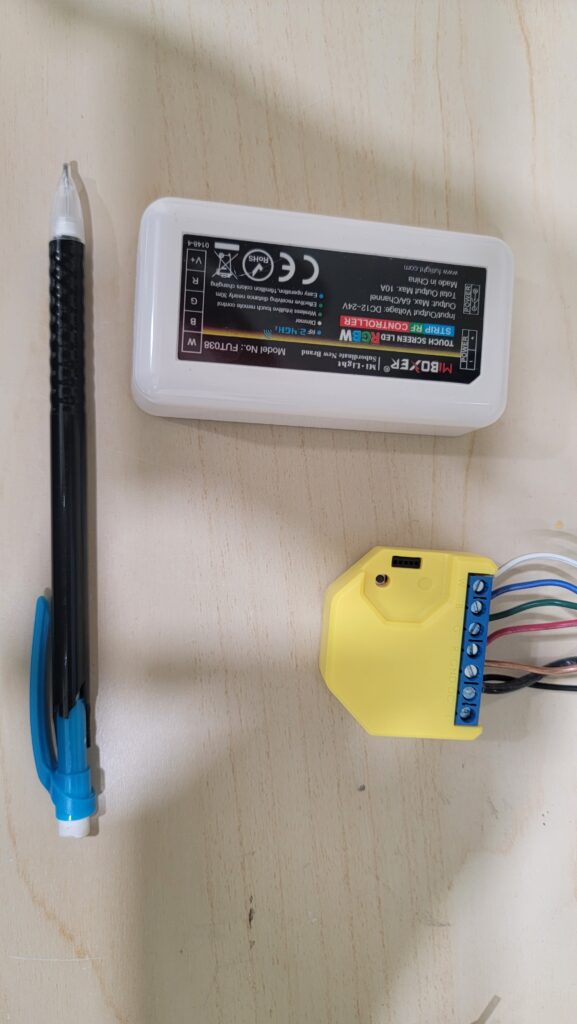With a new Home Assistant instance running, I have a renewed interest in getting everything into Home Assistant that should be in Home Assistant. Now, HA supports a TON of integrations, so this could be a long post. For now, let’s focus on my LED lighting.
Light It Up!
In some remodeling efforts, I have made use of LED light strips for some accent lighting. I have typically purchased my strips from superbrightleds.com. The site has a variety of options for power supplies and controllers, and the pricing is on par with other options. I opted for the Mi-Light/Mi-Boxer controllers on this site for controlling these options.
Why? Well, truthfully, I did not know any better. When I first installed LEDs, I did not have Home Assistant running, and I was less concerned with integration. I had some false hope that the Mi-Light Wi-Fi gateway would have an appropriate REST API that I could use for future integrations.
As it turns out, it does not. To make matters worse, since I did not buy everything at the same time, I ended up getting a new version of the Wi-Fi gateway (MiBoxer), which required a different app. So, now, I have some lights on the Mi-Light app, and some lights on the Mi-Boxer app, but no lights in my Home Assistant. Clearly it is time for a change.
A Myriad of Options
As I started my Google research, I quickly realized there are a ton of options for controlling LED strips. They range from cloud-controlled options to, quite literally, maker-based options where I would need to solder boards and flash firmware.
Truthfully, the research was difficult. There were so many vendors with proprietary software or cloud reliance, something I am really trying to avoid. I was hoping for something a bit more “off the shelf”,” but with the capability to not rely on the cloud and with built-in integration with Home Assistant. Then I found Shelly.
The Shelly Trials
Shelly is a brand from the European company Allterco which focuses on IoT products. They have a number of controllers for smart lighting and control, and their API documentation is publicly available. This allows integrators like Home Assistant to create solid integration packages without trying to reverse engineer calls.
I found the RGBW controller on Amazon, and decided to buy one to test it out. After all, I did not want to run into the same problem with Shelly that I did with MiLight/MiBoxer.
Physical Features

Before I even plugged it in, the size of the unit caught me by surprise. The controller is easily half the size of the MiLight unit, which makes mounting in some of the waterproof boxes I have easier.
The wiring is pretty simple and extremely flexible. Since the unit will run on AC or DC, you simply attach it to positive and ground from your power source. The RGBW wires from the strip go into the corresponding terminals on the controller, and the strip’s power wire is jumped off of the main terminal.
Does this mean that strip is always hot? Yes. You could throw a switch or relay on that strip power, but the strip should only draw power if the lights are on. Those lights are controlled by the RGBW wires, so if the Shelly says it is off, then it is off. It’s important to keep power to the controller, though, otherwise your integration won’t be able to communicate with it.
Connectivity
Shelly provides an app that lets you connect to the RGBW controller to configure its Wi-Fi settings. The app then lets you categorize the device in their cloud and assign it to a room and scene.
However, I do not really care about that. I jumped over into Home Assistant and, lo and behold, a new detected integration popped up. When I configured it, I only needed to add the IP of the device. I statically assigned the IP for that controller using its MAC Address, so I let Home Assistant reach out to that IP for integration.
And that was it. The device appeared in the Shelly integration with all the necessary entities and controls. I was able to control the device with Home Assistant, including change colors, without any issues.
Replacement Time
At about $25 per device, the controllers are not cheap. However, the MiLight controllers, when I bought them, were about $18 each, plus I needed a Wi-Fi controller for every 4 controllers, at $40 each. So, by that math, the MiLight setup was $28 for each individually controlled LED strip with Wi-Fi connectivity. I will have to budget some extra cash to replace my existing controllers with new ones.
Thankfully, the replacement is pretty simple: remove MiLight controller, replace with Shelly, and setup Shelly. Once all my MiLight controllers are gone, I can unplug the two MiLight/MiBoxer Wi-Fi boxes I have. So that is two less devices on the network!